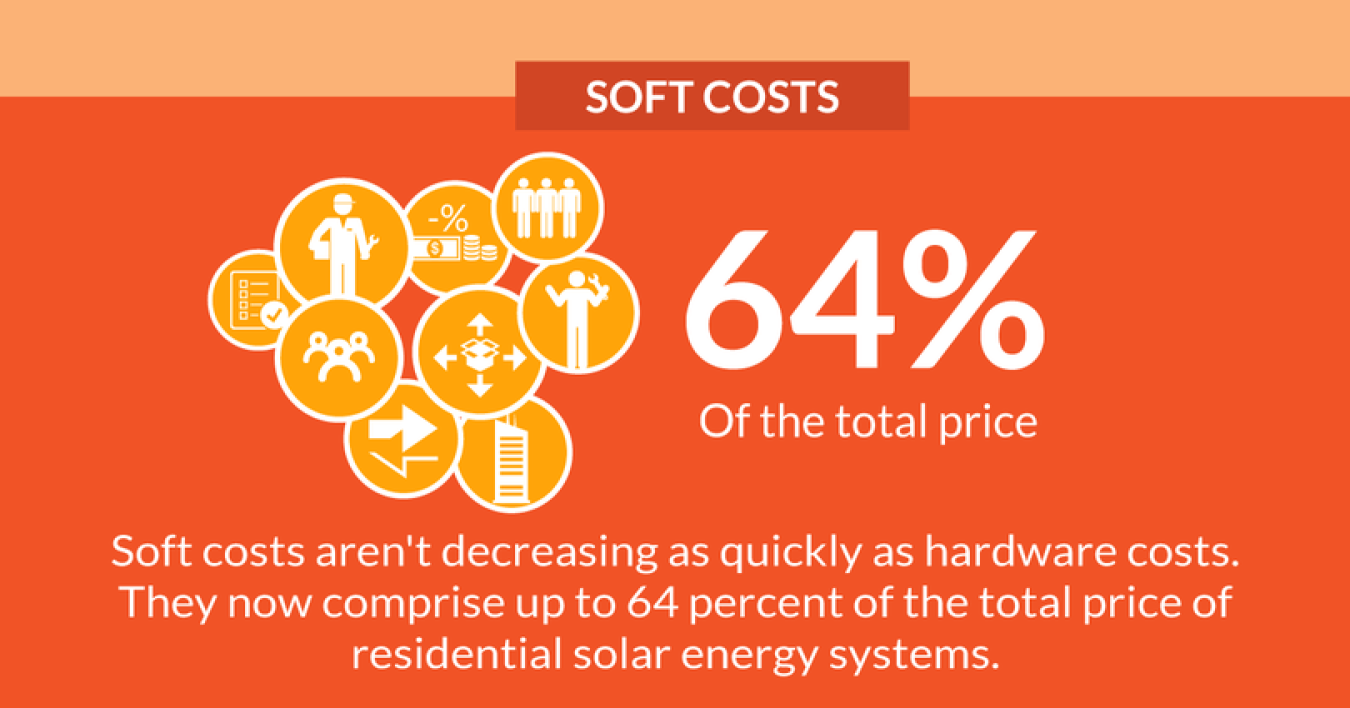
What are solar energy “soft costs” and why do they matter? Here we discuss how soft costs impact the price tag of solar energy systems and explore some of the innovative solutions being developed to cut soft costs and sustain solar energy’s meteoric rise in the United States.
What are soft costs?
Soft costs are the non-hardware costs associated with going solar. These costs include permitting, financing, and installing solar, as well as the expenses solar companies incur to acquire new customers, pay suppliers, and cover their bottom line. These "soft costs" are tacked-on to the overall price a customer pays for a solar energy system.
Image courtesy U.S. Department of Energy
It's no secret solar prices have fallen dramatically in the last five years. However, in order to meet the SunShot Initiative’s goal to make solar energy cost competitive with traditional forms of electricity by 2020, the price must continue to fall.
Image courtesy U.S. Department of Energy
While studies show that increasing global production has reliably led to falling costs, non-hardware costs continue to add up, creating a barrier for many American families interested in solar energy. If we don’t reduce these soft costs in the near future, solar won't be able to reach a tipping point and move beyond early adopters.
Image courtesy SEIA
Because there are so many contributing factors, these costs can be hard to pinpoint and require a variety of solutions.
SunShot Driving Solutions
Through diverse funding programs, the SunShot Soft Costs team works with stakeholders to find new ways to save money for solar customers and businesses.
The solar industry harnesses the creativity of American companies and budding entrepreneurs to improve operations and maximize returns. By creating software that helps solar companies improve sales leads, better manage their portfolios, and make financing more accessible, digital solutions make company operations more efficient. Greater efficiency means they're able to pass along savings to their customers.
From Permit-to-Plug-in
Because there are many jurisdictions, utilities, and differing state and local laws, there isn't a single process or system that businesses follow to get solar customers online. As a result, customers experience a lag time between when they buy a solar system and when it actually gets installed—a frustrating experience that also adds costs.
Image courtesy U.S. Department of Energy
In addition, more support is needed for state and local governments new to solar. SunShot’s technical assistance programs engage experienced solar workers to give governing bodies the knowledge and tools they need to start their own programs. When there is a clearer path forward for customers, new solar businesses, and local leaders, solar has a much better chance of taking off.
That's why we've recently announced the SunShot Prize: The Race to 7-Day Solar, a national prize competition that encourages communities, utilities, and solar companies to work together to have solar systems active in as little as seven days.
Image courtesy U.S. Department of Energy
Training the Workforce of the Future
In addition, solar companies can’t grow without highly skilled workers who are prepared to do their jobs on day one. Today, the solar industry is powered by more than 200,000 Americans and now grows faster than the U.S. economy. We need to minimize training gaps so solar companies can easily recruit new hires and expand at their own pace.
Solar also touches many working in neighboring industries—such as real estate agents, code officials and firefighters—who do not directly work in solar energy but still need to understand how it affects their day-to-day jobs. By educating these professionals as well, we're able to improve solar sales transactions, speed up installations, and lower expenses throughout the value chain.
Because soft costs stem from a variety of sources and contribute to the final cost of a solar system, we’re taking a cross-sector, multidisciplinary approach and enlisting a spectrum of experts across industry, academia and our national labs to bring them down. Innovation, collaboration, and engagement remain key to unlocking a future where solar is both cheap and abundant.
Learn more about the SunShot Soft Costs team and apply for their latest funding opportunity designed to increase knowledge of solar technology evolution and improve state energy planning practices.






